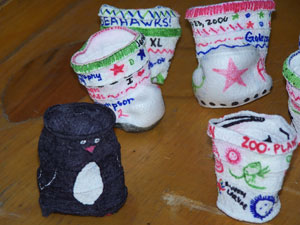|
|
|||||
|
|
|||||
|
January 23rd, Monday Log Entry by AJ Lefevre Internet hasn't been working well for me. I have only had a few quick moments to try it, and so far it hasn't worked for more than a few minutes here and there. Wendy and I wrote an update for the website yesterday, but the computer dumped it when we weren't looking. Arg. So, I'll give you a quick update now. Our (Wendy and my) first station (BIO 6) was a nightmare. The CTD bottles wouldn't fire properly, so we had to try several times before we got water samples. Our first incubations went swimmingly (ha ha). We arrived at our second station (BIO 2)around 145 AM this morning (local time). CTD worked fine, water collection was fine...had a few mistakes with our dilution setup, but we're hoping it won't be too big of a deal. (Fe was added to two non-Fe bottles, but it was caught quickly and fixed. Then two pipets, Fe and non-Fe were mixed up, so there may have been some Fe contamination in the non-Fe bottles. We may be able to see a difference in our results, but we are hoping that the contamination wasn't too significant, especially considering our carboys sit without caps on, on a rusty ship deck while we collect water, we label the bottles with rusty nails, etc.) Mistakes are easy enough to make, but when we have had so little sleep (and so much sea sickness), it takes an incredible amount of focus to carry out the simplest of tasks. In my "spare time" I've been on watch, sleeping (a few hours a day or so), eating (when I can), counting (ugh), helping out others as needed, and going to 'class.' One of our professors Seelye has volunteered to try to help us out with our Physical Oceanography homework by giving us lecures once a day. Most of us (except for a few geo and phys folks who have more down time) are running on zombie auto-pilot and are unable to really absorb anything, but we are plugging along as best we can. My sea sickness seems to be subsiding. Still comes and goes. (Nothing makes it come like counting bacteria...Mom always said bacteria would make me sick!) I got to go outside today! In the daylight! Helped Jaqui with a box core this morning. I had never been involved with the process before and found it pretty interesting. We have arrived at Jaqui's next station and we are dropping the box corer now. We're hoping for a) sediment and b) the corer tripping on the first try. On the last station it didn't trip the first two times she sent it down. Put us a little behind schedule, as it takes it a while to drop to 1000m and be pulled back up three times. (There is no way to know whether or not it has tripped without bringing it back all the way up.) The depth at this station is about twice that of the last, so it will take even longer to drop 2000m. Wendy and I will be collecting our t=24 samples from our second station tomorrow morning, probably during our watch (4-8am). They don't have the next several days of stations posted, so we are not quite sure when we will arrive at our third station. I'll keep trying to upload photos and get into my website - hold your breath. If nothing else I will try to e-mail again when I'm not working or staring into a microscope. There is currently a styrofoam cup decorating party happening in the lab. When instruments are sent to depth, styrofoam cups accompanying them are shrunk to a portion of their original size - one of the reasons I want to be an oceanographer!.
Styrofoam cups are good insulators for hot drinks because of the trapped air pockets in them. At normal atmospheric pressure (14.7 lbs per sq in (psi)), the size of the air pockets remains constant. At 2 miles below the ocean waves, however, the pressure is crushing - about 3,500 psi. At that depth, the air pockets are literally squeezed out and the cups shrink |
|
||||
|
|||||

